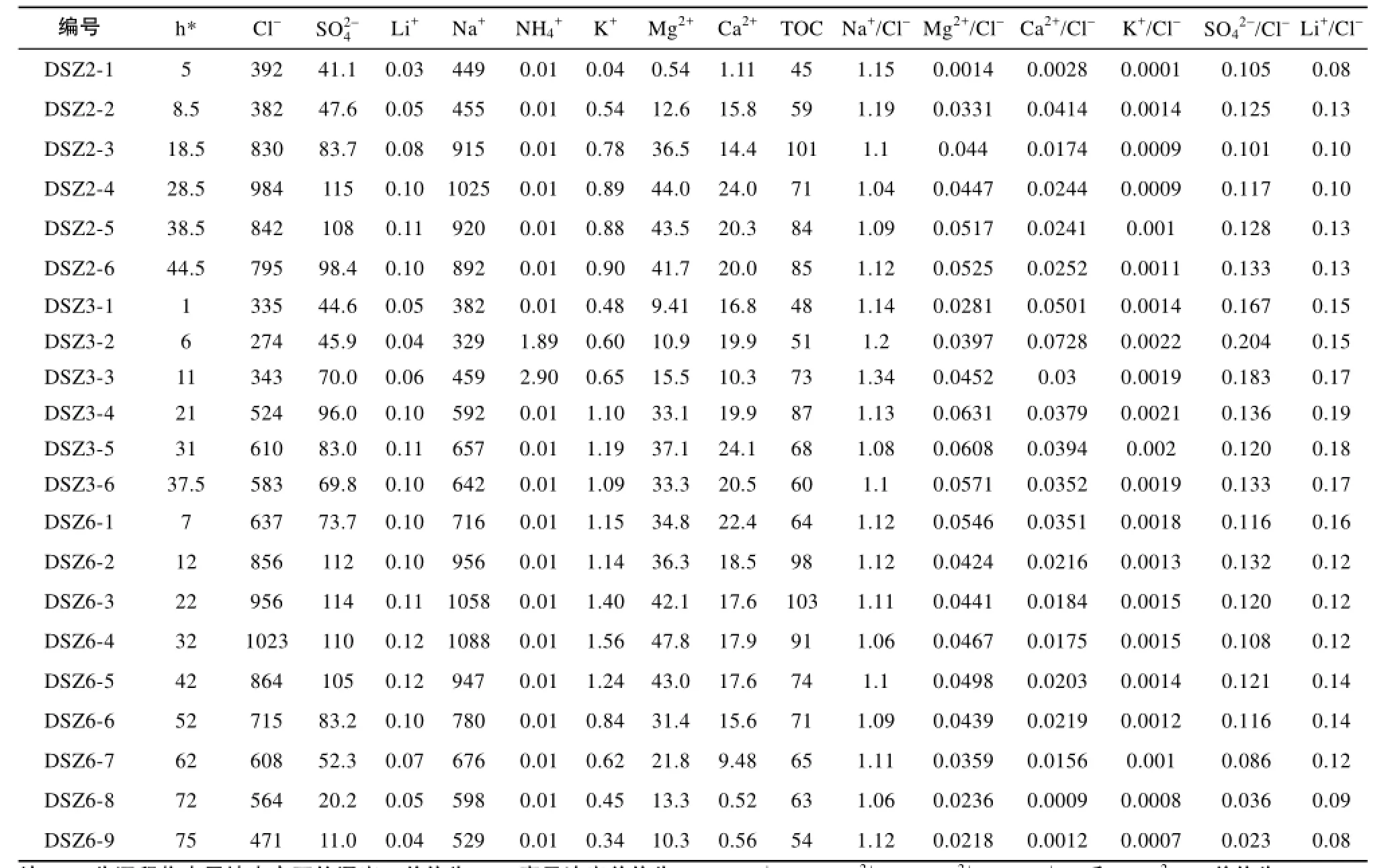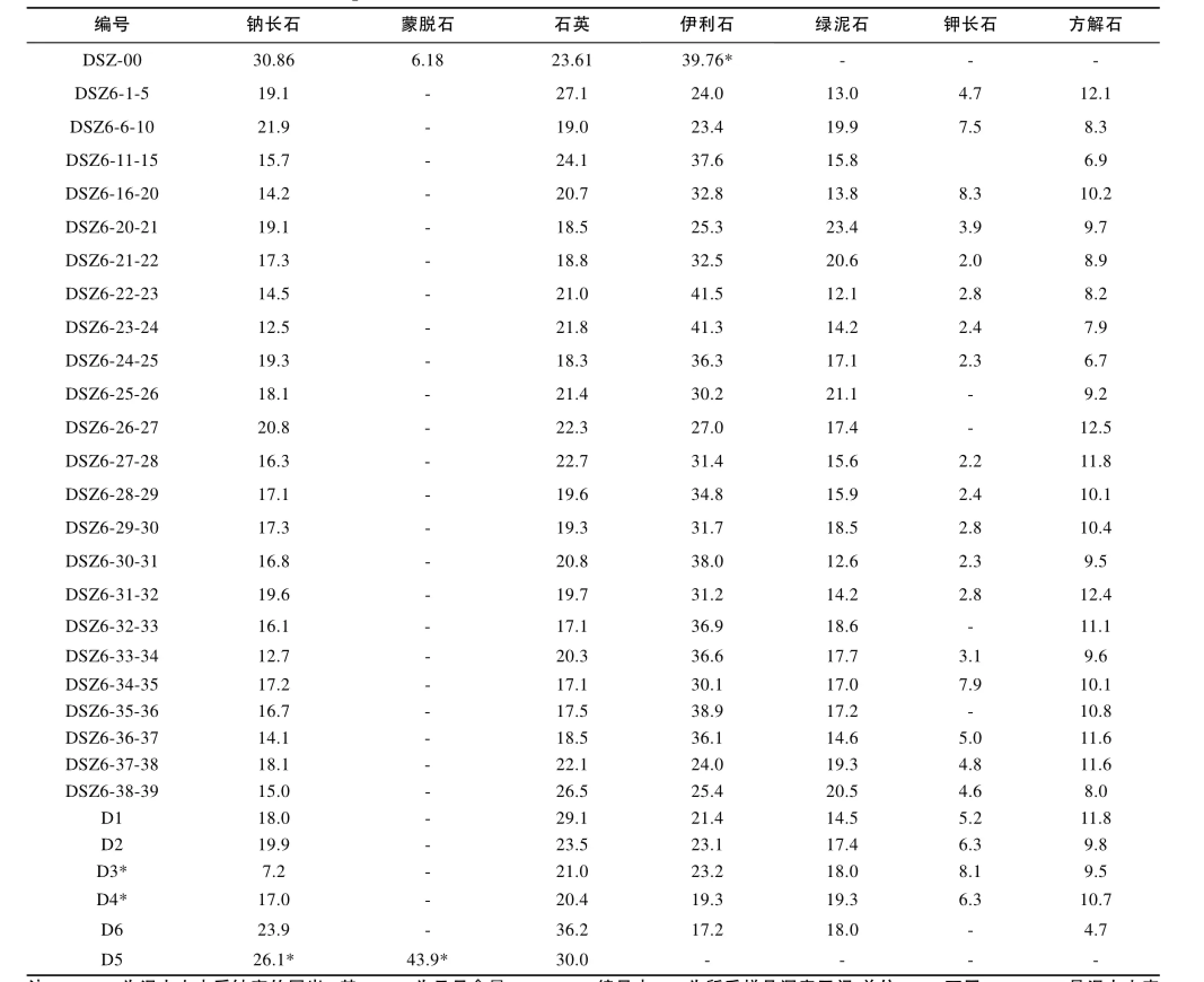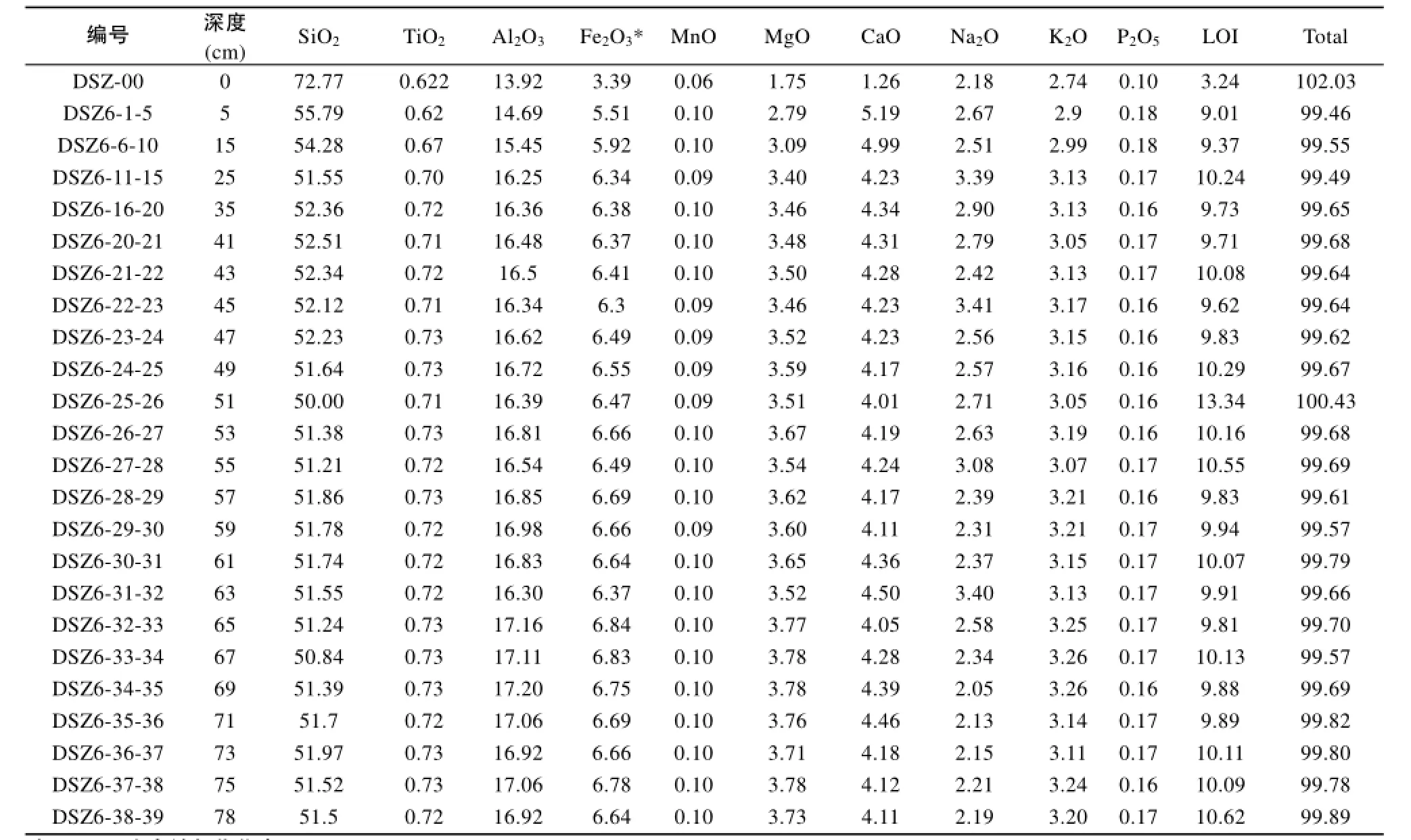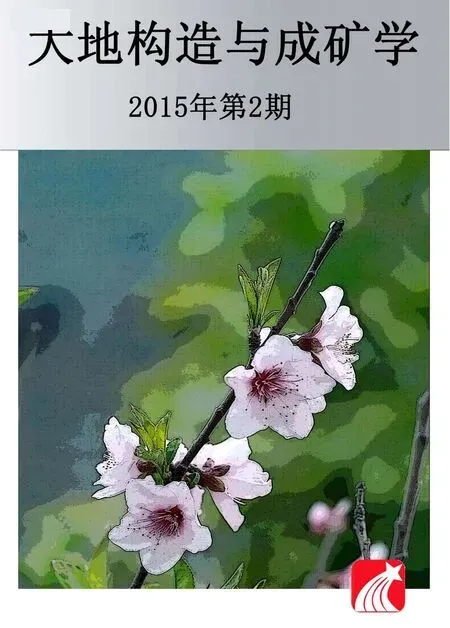新疆独山子泥火山沉积物及孔隙水的地球化学特征与流体来源
黄华谷, 李 牛, 王钦贤, 陈多福
(1.广东省地质调查院, 广东 广州 510080; 2.中国科学院 广州地球化学研究所 边缘海地质重点实验室,广东 广州510640)
新疆独山子泥火山沉积物及孔隙水的地球化学特征与流体来源
黄华谷1,2, 李 牛2, 王钦贤2, 陈多福2
(1.广东省地质调查院, 广东 广州 510080; 2.中国科学院 广州地球化学研究所 边缘海地质重点实验室,广东 广州510640)
对陆地泥火山流体来源及其向地表渗漏过程中的改造作用开展研究, 有利于加深理解泥火山释放甲烷的碳排放过程。新疆准噶尔盆地南缘独山子泥火山柱状沉积物和地表沉积物的矿物和元素组成, 以及沉积物孔隙水离子组成等的分析结果显示, 泥火山沉积物孔隙水Na+和Cl–间具有很好的正相关性, 具有比海水高的Na+/Cl–和Li+/Cl–值、低的K+/Cl–和Mg2+/Cl–。泥火山沉积物与围岩相比, 富集伊利石、绿泥石和方解石, 缺少蒙脱石, 富集Ca、亏损Si, 这些变化主要与黏土矿物的脱水转变有关。表明泥火山流体主要来源于深部低盐度沉积物孔隙水, 但经历了地表的蒸发作用, 并混合了大气降水。
泥火山; 孔隙水; 沉积物; 地球化学; 改造作用; 流体来源; 新疆
0 引 言
泥火山是地下深部高压泥浆和气体为主的流体,通过断层等高渗透性通道向地表运移, 并喷出地表,在地表形成的锥状沉积体(Milkov, 2000; Kopf, 2002)。泥火山活动过程中往往喷出大量气体, 绝大部分喷出的气体以CH4为主, 小部分以CO2或N2为主(Dimitrov, 2002)。估计每年泥火山向大气排放CH4的总量可达10~20 Tg(Etiope et al., 2011)。CH4是重要的温室气体, 其温室效应是CO2的20倍以上(Shindell et al., 2009)。因此, 泥火山释放CH4在全球大气CH4估算和气候变化中是一个不可忽略的重要因素(Milkov, 2005; Milkov and Etiope, 2005)。
泥火山在全球分布比较广泛, 但主要发育在阿尔卑斯山–特提斯带(阿尔卑斯山–黑海–里海–喜马拉雅山)和环太平洋带(Kopf, 2002; Sun, 2010)。泥火山与油气藏有着空间上和成因上的联系, 很多大型含油气盆地(如准噶尔盆地、阿塞拜疆和墨西哥湾等)都发育有泥火山(Neurauter and Bryant, 1990; Fu et al., 2007; Etiope et al., 2009; Mazzini, 2009; Zheng et al., 2010a, 2010b)。
我国新疆准噶尔盆地南缘发育了一些与油气田相关联的泥火山, 喷溢气体组分主要为CH4, 来源深度大约为3600 m, 同时也可能存在浅部CO2还原反应所生成的次生CH4(Nakada et al., 2011; 高苑等, 2012)。泥火山渗漏气体组分、碳同位素和氦同位素具有典型的热成因和壳源特征(戴金星等, 2012; 高苑等, 2012; Wan et al., 2013)。这些泥火山的形成和泥浆喷溢可能与地震活动有关(王道, 2000; 高小其等, 2008), 是压力差导致地下水沿断裂带上升, 与通道周围泥质岩的细颗粒物质混合形成泥浆, 上涌喷出地表而形成(李梦等, 2013)。最为典型的独山子泥火山已经活动了几十年(李锰等, 1996; 王道等, 1997), 至今仍不断向外喷出泥浆和气体, 而且泥火山喷出流体中可见油花, 显示了可能来源于深部的油气储层。对油花的生物标志化合物的研究表明,油源可能是侏罗系与古近系烃源岩的混合产物(李梦等, 2013)。
陆地泥火山喷发的流体地球化学研究表明, 泥火山释放的流体具有多种来源, 而且在地下具有复杂的运移过程, 并经历了多种改造作用, 流体原有的化学成分和同位素信息均会发生改变(Dia et al., 1999; You et al., 2004; Mazzini, 2009)。陆地泥火山流体可能来自于沉积物(岩)孔隙水、深层卤水, 并有大气降水的混入, 从而导致原有的化学成分和同位素信息会受到水–岩作用、有机质降解、流体中甲烷的有氧和厌氧氧化作用或流体与围岩之间的化学交换作用等的改造(Martin et al., 1996; Planke et al., 2003; Nath et al., 2008; Liu et al., 2009; Cheng et al., 2012)。本文拟通过研究准噶尔盆地南缘独山子泥火山柱状沉积物和地表沉积物的矿物、元素和孔隙水离子组成特征, 探讨泥火山流体的来源及可能经历的改造作用。
1 样品与分析方法
独山子泥火山位于我国新疆准噶尔盆地南缘(Fu et al., 2007), 距离独山子城区约1 km, 海拨896 m (坐标为N44°18′19.34″, E84°50′46.45″)(图1)。该泥火山曾经历过多次活动, 最近的一次强烈活动发生在1995年(王道等, 1997)。目前仅存2个活动的泥浆喷口, 其中一个堆积泥火山锥, 不断有泥浆和甲烷气体溢出。独山子山顶分布一个较大的积水潭, 水潭底部沉积物可见有大量的气泡冒出。我们在泥火山喷发形成的面积约为6.8 m×23.8 m的水池中采集了3个沉积柱样(DSZ6, DSZ3, DSZ2)及孔隙水样品(图1), 在水池周围地表采集了6个沉积物样。泥火山柱状沉积物孔隙水用Rhizon采样器依3~10 cm间距采集, 获得的孔隙水3~15 ml加入氯化银稳定剂保存, 沉积物样依2 cm间隔采集。

图1 新疆准噶尔盆地南缘独山子泥火山地理位置图和样品采集Fig.1 Map showing the location of the Dushanzi (DSZ) mud volcano and sampling sites
孔隙水离子组成用超纯水稀释1000倍后, 孔隙水的Cl–、Na+、K+、Li+、Mg2+、Ca2+、等离子的含量分析在中国科学院广州地球化学研究所同位素地球化学国家重点实验室完成, 采用美国戴安公司Dionex-ICS-900型离子色谱仪测试, 检出最低值大约为0.1 μg/g, 精度及准确度都小于5%。
孔隙水的总有机碳(TOC)在中国科学院广州地球化学研究所有机地球化学国家重点实验室TOC-V CPH型总有机碳分析仪器上完成, 可测定范围为0~ 25000 μg/L, 检测下限为4 μg/L, 测定精度≤1.5%。
全岩粉末样品的物相分析(XRD)由中国科学院广州地球化学研究所的Bruker X-射线衍射仪(D8 Advance)完成, 工作参数为Cu靶Kα射线, 石墨单色器, 测试电压为40 kV, 电流为40 mA, 扫描角度为5°~70°(2θ) , 步进扫描, 步宽为0.02°, 发散狭缝为0.5°, 接收狭缝为0.15 mm, 防散射狭缝为0.5°,矿物含量依面积法进行半定量分析, 结果由SIROQUANT程序完成(Tayor, 1991)。
全岩主量元素采用中国科学院广州地球化学研究所同位素地球化学国家重点实验室ZSX100e的Rigak X-射线荧光光谱仪测试, 由 36种涵盖硅酸盐样品范围的参考标准物质双变量拟合工作曲线确定,基体校正依经验Traill-Lachance程序进行, 分析精度优于1%~5%(Li et al., 2005)。
2 分析结果
2.1 孔隙水离子成分
独山子泥火山沉积物孔隙水离子成分分析结果见表1。除了DSZ2的TOC外, 所有离子成分变化规律基本类似, 总体呈现出随深度变化先增大后减小, 在中部达到最大值的分布特征(图2)。

图2 独山子泥火山DSZ2, DSZ3和DSZ6中Na+、Cl-、Mg2+、Ca2+、和TOC随深度变化图Fig.2 Profiles of Na+、Cl-、Mg2+、Ca2+、and TOC in the cores DSZ2, DSZ3 and DSZ6 of the Dushanzi mud volcano

表 1 独山子泥火山的沉积物孔隙水离子化学成分Table 1 Ion compositions of sediment pore fluids from the DSZ mud volcano
DSZ2的Cl–浓度为382~984 mM, 部分样品超过了正常海水的Cl–浓度(556 mM), 垂向上最高值出现在深度28.5 cm附近, 最低值出现在沉积物表层附近。浓度为41.1~115 mM, Na+浓度为449~1025 mM, Mg2+浓度为0.54~44.01 mM, Ca2+浓度为1.11~24 mM, TOC浓度为45~101 μg/L。
DSZ3各离子浓度变化和DSZ2类似, 只是最低值不是出现在地表附近, 而是在6 cm左右。
DSZ6采样深度达到了80 cm, Na+、Cl–、Mg2+和Ca2+在深度32 cm处达到最高值以后持续下降。和TOC在22 cm处达到最高值以后持续下降,最低值分别达到了10.98 mM和54 μg/L, 特别是Ca2+浓度在75 cm处降低到0.56 mM。
2.2 沉积物的矿物和主量元素
XRD分析结果显示, 独山子泥火山地表沉积物与柱状沉积物的矿物成分类似, 都以伊利石、绿泥石、石英和钠长石为主, 含少量的钾长石和方解石,个别样品含少量其他矿物, 如D5为白色角砾, 石英含量为30%, 重晶石含量为26.1%, 石膏含量为43.9%(表2)。
独山子泥火山(DSZ6)所有柱状沉积物样品都含有绿泥石、伊利石、石英、钾长石、钠长石和方解石(表2), 与泥火山围岩DSZ-00(Fu et al., 2007; Zheng et al., 2010a, 2010b)相比, 泥火山沉积物相对富集方解石、伊利石和绿泥石, 没有蒙脱石。其中,独山子泥火山沉积物中的方解石达到6.7%~12.5%。
泥火山沉积物所有样品都具有高含量的SiO2(50.00%~60.78%)和Al2O3(14.69%~17.20%)(表3),相对于围岩样品DSZ-00, 泥火山沉积物的Ca极度富集, 其次Fe、Mn、Mg和P为富集, K、Na、Al和Ti相似, Si稍有亏损(图3)。
3 讨 论
相对于其他离子, 独山子泥火山流体主要富集Na+和Cl–, 这和世界其他地区发育的泥火山流体成分特征基本一致(Dia et al., 1999; You et al., 2004; Hensen et al., 2007; Liu et al., 2009; Chao et al., 2011)。独山子泥火山流体在Na+-Cl-图解中, 虽然部分样品Cl–值高于海水, 但同海水值一起均落在同一条直线上(图4), 说明独山子泥火山流体可能具有同一来源, 即来自于沉积物孔隙水。

表 2 独山子泥火山柱状沉积物、围岩和地表沉积物的矿物成分(%)Table 2 Mineral compositions(%) of the DSZ6 core sediments, host rock and surface sediments

图3 独山子泥火山DSZ6柱状沉积物的主量元素围岩标准化图Fig.3 Major elements distribution of the DSZ6 core sediments of the DSZ mud volcano normalized by the host rock

图4 独山子泥火山孔隙水中Na+和Cl-关系图Fig.4 Plot of Na+vs Cl-of the pore water of the DSZ core sediments

表 3 泥火山柱状沉积物和围岩XRF测定的主量元素含量(%)Table 3 Major element compositions(%) of the DSZ6 core sediments and host rock
独山子泥火山3个柱状沉积物孔隙水Cl-浓度为274~1023 mM, 远高于代表源区地表喷口池水中的Cl-含量(72.4~180 mM, Nakada et al., 2011), 其最高值也远大于正常海水值(556 mM)。考虑到准噶尔盆地高蒸发率和研究区内不发育石盐, 沉积物孔隙水中如此高的Cl-浓度可能是由地表强烈蒸发作用所引起。孔隙水 Na+-Cl-显著正相关也显示了地表蒸发作用。这一现象与相似地理与气候条件下的阿塞拜疆Dashgil泥火山相一致, 其沉积物孔隙水的高盐度也是由地表蒸发作用引起的(Mazzini et al., 2009)。
由于泥浆和流体快速喷出地表, 遭受生物和非生物作用相对较弱, 而且Cl是孔隙水中化学性质最为保守的元素, 因此地表喷口池水离子组成可能代表泥火山源区离子性质。独山子泥火山喷口池水中Cl-含量为72.4~180 mM(Nakada et al., 2011), 约为海水值的1/3。而且独山子泥火山孔隙水相对于海水具有更高的Na+/Cl-和Li+/Cl-值, 更低的K+/Cl-和Mg2+/Cl-值(表1)。
世界上大多数泥火山相对于海水都亏损Cl-, 通常被解释为黏土矿物脱水(Kastner et al., 1991; Dia et al., 1999; Brown et al., 2001; Dählmann and de Lange, 2003; You et al., 2004), 或者大气降水注入的结果(Aquilina et al., 1997; Dia et al., 1999)。在地温大于60 ℃的深度以下, 黏土矿物脱水被认为是产生流体低盐度的主要原因(Vrolijk et al., 1991; Kastner et al., 1991, 1993)。此外, 蒙脱石向伊利石转化不仅降低孔隙水盐度, 而且释放蒙脱石层间Na+和移走流体中的K+。模拟实验证明约50 ℃时海相沉积物将释放Li+和B+(Chan et al., 1994; You et al., 1996; James et al., 2003)。因此, 孔隙水中Li的升高和K的丢失可能指示黏土矿物脱水的作用。
同时, 独山子泥火山沉积物中含有大量的伊利石和绿泥石, 而未受泥火山活动影响的泥火山围岩都含蒙脱石(表2)。Nakada et al. (2011)运用自生方解石和水之间的氧同位素分馏获得独山子平衡温度,在深度3670±200 m可能为81 ℃, 达到了蒙脱石脱水反应和蒙脱石向伊利石转化所需要的温度。在如此高的温度下, 会导致水–岩作用的发生, 沉积物中Ca、Si溶解和Mn、Fe富集。而且泥火山流体在深部运移或喷发出地表以后, 由于离子浓度的变化,导致流体中方解石的沉淀, 沉积物中Ca、Mg和Fe富集。Nakada et al. (2011)对独山子泥火山地表喷口池水中离子饱和系数通过计算得出, 泥火山流体对于方解石和白云石都是饱和。以上均说明独山子泥火山深部可能发生蒙脱石脱水(包括层间水的丢失)和温度升高引起的蒙脱石向伊利石的转化, 导致了孔隙水盐度的降低。
此外, 独山子泥火山3个柱状沉积物孔隙水Cl-浓度均从地表向下逐渐增高, 在约30 cm处达到最大值, 然后向下Cl-浓度下降。台湾雷公湖泥火山柱状沉积物孔隙水中Cl-浓度为527~666 mM, 从表层往下不断增加, 在9 cm处达到最高值后随着深度加深而降低, 也存在相似的分布特征(Chang et al., 2012)。因此独山子泥火山30 cm以下降低的Cl-浓度, 可能说明在深部的流体具有低盐度特征, 可能与黏土矿物脱水有关。30 cm以下的沉积物孔隙水离子组成可能是源区低盐度的流体与地表经过蒸发作用的流体相混合的结果, 而在30 cm以上的孔隙水离子组成可能受到降水稀释作用的影响。
4 结 论
新疆准噶尔盆地南缘独山子泥火山流体和沉积物的地球化学特征显示, 泥火山流体成分主要为Na+和Cl–, 且Na+与Cl–呈显著的正相关, 表明独山子泥火山流体来源于沉积物孔隙水。柱状沉积物孔隙水Cl–含量远高于代表源区的地表喷口池水中的值, 显示了地表蒸发作用的影响。
泥火山沉积物孔隙水Cl-浓度从地表向下逐渐增高, 在约30 cm处达到最大值, 然后随深度加深而降低。并且, 泥火山沉积物中含有较多的伊利石和绿泥石, 而未受泥火山活动影响的泥火山围岩则富含蒙脱石。此外, 与围岩DSZ-00相比, 泥火山沉积富集Ca、Fe、Mn、Mg和P, 亏损Si, 说明独山子泥火山的深部源区沉积物发生了蒙脱石脱水作用,形成了源区的低盐度流体, 30 cm以下沉积物孔隙水离子组成是源区低盐度流体与蒸发作用混合的结果,而30 cm以上的孔隙水离子组成可能受到降水稀释作用的影响。
致谢: 中国科学院广州地球化学研究所陈毅凤副研究员和曹运诚参加了野外工作, 野外工作中得到了中国科学院地质与地球物理研究所兰州油气资源研究中心郑国东研究员的建议和帮助。感谢两位审稿人对本文评审提出的修改意见。
戴金星, 吴小奇, 倪云燕, 汪泽成, 赵长毅, 王兆云, 刘桂侠. 2012. 准噶尔盆地南缘泥火山天然气的地球化学特征. 中国科学(D辑), 42 (2): 178–190.
高小其, 王海涛, 高国英, 高歌, 王中道, 陆明勇, 桑丽荣, 杨晓芳, 郭卫英, 许秋龙. 2008. 霍尔果斯泥火山活动与新疆地区中强以上地震活动关系的初步研究. 地震地质, 30(2): 464–472.
高苑, 王永莉, 郑国东, 孟培, 吴应琴, 杨辉, 张虹, 王有孝. 2012. 新疆准噶尔盆地独山子泥火山天然气地球化学特征. 地球学报, 33(6): 989–994.
李锰, 王道, 李茂伟, 戴晓敏. 1996. 新疆独山子泥火山喷发特征的研究. 内陆地震, 10(4): 359–362.
李梦, 刘冬冬, 郭召杰. 2013. 准噶尔盆地南缘泥火山活动及其伴生油苗的地球化学特征和意义. 高校地质学报, 19(3): 484–490.
王道. 2000. 新疆北天山地区泥火山与地震. 内陆地震, 12(4): 350–353.
王道, 李茂玮, 李锰, 戴晓敏. 1997. 新疆独山子泥火山喷发的初步研究. 地震地质, 19: 14–16.
Aquilina L, Dia A N, Boulegue J, Bourgois J and Fouillac A M. 1997. Massive barite deposits in the convergent margin off Peru: Implications for fluid circulation within subduction zones. Geochimica et Cosmochimica Acta, 61(6): 1233–1245.
Brown K M, Saffer D M and Bekins B A. 2001. Smectite diagenesis, pore-water freshening, and fluid flow at the toe of the Nankai wedge. Earth and Planetary Science Letters, 194(1–2): 97–109.
Chan L H, Gieskes J M, You C F and Edmond J M. 1994. Lithium isotope geochemistry of sediments and hydrothermal fluids of the Guaymas basin, Gulf of California. Geochimica et Cosmochimica Acta, 58(20): 4443–4454.
Chang Y H, Cheng T W, Lai W J, Tsai W Y, Sun C H, Lin L H and Wang P L. 2012. Microbial methane cycling in a terrestrial mud volcano in eastern Taiwan. Environmental Microbiology, 14(4): 895–908.
Chao H C, You C F, Wang B S, Chung C H and Huang K F. 2011. Boron isotopic composition of mud volcano fluids: Implications for fluid migration in shallow subduction zones. Earth and Planetary Science Letters, 305(1–2): 32–44.
Cheng T W, Chang Y H, Tang S L, Tseng C H, Chiang P W, Chang K T, Sun C H, Chen Y G, Kuo H C, Wang C H, Chu P H, Song S R, Wang P L and Lin L H. 2012. Metabolic stratification driven by surface and subsurface interactions in a terrestrial mud volcano.The ISME Journal, 6(12): 2280–2290.
Dählmann A and de Lange G J. 2003. Fluid-sediment interactions at Eastern Mediterranean mud volcanoes: A stable isotope study from ODP Leg 160. Earth and Planetary Science Letters, 212(3–4): 377–391.
Dia A N, Castrec-Rouelle M, Boulegue J and Comeau P. 1999. Trinidad mud volcanoes: Where do the expelled fluids come from? Geochimica et Cosmochimica Acta, 63(7–8): 1023–1038.
Dimitrov L I. 2002. Mud volcanoes—the most important pathway for degassing deeply buried sediments. Earth-Science Reviews, 59(1–4): 49–76.
Etiope G, Feyzullayev A, Milkov A V, Waseda A, Mizobe K and Sun C H. 2009. Evidence of subsurface anaerobic biodegradation of hydrocarbons and potential secondary methanogenesis in terrestrial mud volcanoes. Marine and Petroleum Geology, 26(9): 1692–1703.
Etiope G, Nakada R, Tanaka K and Yoshida N. 2011. Gas seepage from Tokamachi mud volcanoes, onshore Niigata Basin (Japan): Origin, post-genetic alterations and CH4-CO2fluxes. Applied Geochemistry, 26(3): 348–359.
Fu B H, Zheng G D, Ninomiya, Y, Wang C Y and Sun G. 2007. Mapping hydrocarbon-induced mineralogical alterations in the northern Tian Shan using ASTER multispectral data. Terra Nova, 19(4): 225–231.
Hensen C, Nuzzo M, Hornibrook E, Pinheiro L M, Bock B, Magalhaes V H and Brückmanna W. 2007. Sources of mud volcano fluids in the Gulf of Cadiz—indications for hydrothermal imprint. Geochimica et Cosmochimica Acta, 71(5): 1232–1248.
James R H, Allen D E and Seyfried W E. 2003. An experimental study of alteration of oceanic crust and terrigenous sediments at moderate temperatures (51 to 350 ℃): Insights as to chemical processes in near-shore ridge-flank hydrothermal systems. Geochimica et Cosmochimica Acta, 67(4): 681–691.
Kastner M, Elderfield H, Jenkins W J, Gieskes J M and Gamo T. 1993. Geochemical and isotopic evidence for fluid in the western Nankai subduction zone, Japan // Hill I A, Taira A and Firth J V. Proceeding of the Ocean Drilling Program Scientific Reports 131. Ocean Drilling Program, College Station, TX: 397–413.
Kastner M, Elderfield H and Martin J B. 1991. Fluids in convergent margins: what do we know about their composition, origin, role in diagenesis and importance for oceanic chemical fluxes? Philosophical Transactions of the Royal Society A, 335, 243–259.
Kopf A J. 2002. Significance of mud volcanism. Reviews of Geophysics, 40(2): 1–52.
Li X H, Qi C S, Liu Y, Liang X R, Tu X L, Xie L W and Yang Y H. 2005. Petrogenesis of the Neoproterozoic bimodal volcanic rocks along the western margin of the Yangtze Block: New constraints from Hf isotopes and Fe/Mn ratios. Chinese Science Bulletin, 50(21): 2481–2486.
Liu C C, Jean J S, Nath B, Lee M K, Hor L I, Lin K H and Maity J P. 2009. Geochemical characteristics of the fluids and muds from two southern Taiwan mud volcanoes: Implications for water-sediment interaction and groundwater arsenic enrichment. Applied Geochemistry, 24(9): 1793–1802.
Martin J B, Kastner M, Henry P, LePichon X and Lallement S. 1996. Chemical and isotopic evidence for sources of fluids in a mud volcano field seaward of the Barbados accretionary wedge. Journal of Geophysical Research-Solid Earth, 101(B9): 20325–20345.
Mazzini A. 2009. Mud volcanism: Processes and implications. Marine and Petroleum Geology, 26(9): 1677–1680.
Mazzini A, Svensen H, Planke S, Guliyev I, Akhmanov G G, Fallik T and Banks D. 2009. When mud volcanoes sleep: Insight from seep geochemistry at the Dashgil mud volcano, Azerbaijan. Marine and Petroleum Geology, 26(9): 1704–1715.
Milkov A V. 2000. Worldwide distribution of submarine mud volcanoes and associated gas hydrates. Marine Geology, 167(1–2): 29–42.
Milkov A V. 2005. Global distribution of mud volcanoes and their significance in petroleum exploration as a source of methane in the atmosphere and hydrosphere and as a geohazard // Martinelli G and Panahi B. Mud Volcanoes, Geodynamics and Seismicity: 29–34.
Milkov A V and Etiope G. 2005. Global methane emission through mud volcanoes and its past and present impact on earth climate. International Journal of Earth Sciences, 94(3): 493–494.
Nakada R, Takahashi Y, Tsunogai U, Zheng G D, Shimizu H and Hattori K H. 2011. A geochemical study on mud volcanoes in the Junggar Basin, China. Applied Geochemistry, 26(7): 1065–1076.
Nath B, Jean J S, Lee M K, Yang H J and Liu C C. 2008. Geochemistry of high arsenic groundwater in Chia-Nan plain, Southwestern Taiwan: Possible sources andreactive transport of arsenic. Journal of Contaminant Hydrology, 99(1–4): 85–96.
Neurauter T W and Bryant W R. 1990. Seismic expression of sedimentary volcanism on the continental slope, northern Gulf of Mexico. Geo-Marine Letters, 10(4): 225–231.
Planke S, Svensen H, Hovland M, Banks D A and Jamtveit B. 2003. Mud and fluid migration in active mud volcanoes in Azerbaijan. Geo-Marine Letters, 23(3–4): 258–268.
Shindell D T, Faluvegi G, Koch D M, Schmidt G A, Unger N and Bauer S E. 2009. Improved Attribution of Climate Forcing to Emissions. Science, 326(5953): 716–718.
Sun C H, Chang S C, Kuo C L, Wu J C, Shao P H and Oung J N. 2010. Origins of Taiwan’s mud volcanoes: Evidence from geochemistry. Journal of Asian Earth Sciences, 37(2): 105–116.
Taylor J C. 1991. Computer programs for standardless quantitative analysis of minerals using the full powder diffraction profile. Powder Diffraction, 6: 2–9.
Vrolijk P, Fisher A and Gieskes J. 1991. Geochemical and geothermal evidence for fluid migration in the Barbados accretionary prism (ODP Leg 110). Geophysical Research Letters, 18(5): 947–950.
Wan Z F, Shi Q H, Guo F, Zhong Y and Xia B. 2013. Gases in Southern Junggar Basin mud volcanoes: Chemical composition, stable carbon isotopes, and gas origin. Journal of Natural Gas Science and Engineering, 14: 108–115.
You C F, Castillo P R, Gieskes J M, Chan L H and Spivack A J. 1996. Trace element behavior in hydrothermal experiments: Implications for fluid processes at shallow depths in subduction zones. Earth and Planetary Science Letters, 140(1–4): 41–52.
You C F, Gieskes J M, Lee T, Yui T F and Chen H W. 2004. Geochemistry of mud volcano fluids in the Taiwan accretionary prism. Applied Geochemistry, 19(5): 695–707. Zheng G, Fu B H, Takahashi Y, Kuno A, Matsuo M and Zhang J. 2010a. Chemical speciation of redox sensitive elements during hydrocarbon leaching in the Junggar Basin, Northwest China. Journal of Asian Earth Sciences, 39(6): 713–723.
Zheng G D, Fu B H, Kuno A and Matsuo M. 2010b. Iron speciation in bleached rocks by hydrocarbon leaching in Dushanzi Mud Volcano, NW China. Journal of Physics: Conference Series 217 012048, doi: 10.1088/1742–6596/217/1/012048.
Geochemical Features and Origins of Pore Fluids and Sediments of the Mud Volcanoes in Southern Margin of the Junggar Basin, Xinjiang, Northwestern China
HUANG Huagu1,2, LI Niu2, WANG Qinxian2and CHEN Duofu2
(1. Guangdong Geologic Survey Institute, Guangzhou 510080, Guangdong, China; 2. Key Laboratory of Marginal Sea Geology, Guangzhou Institute of Geochemistry, Chinese Academy of Sciences, Guangzhou 510640, Guangdong, China)
Fluid sources and geochemical processes involved in terrestrial mud volcanoes are of great significance for understanding the chemical processes of methane emission to the atmosphere. Mud sediments ejected from the Dushanzi mud volcano, which is located along the southern margin of the Junggar Basin, northwestern China, were collected by hand core sampling. The ionic compositions of the pore fluids, minerals and major elements of the ejected sediments and surface sediments were analyzed. The results showed that significant correlation between Cl–and Na+in pore fluids. Relative to seawater, the mud volcano fluids have higher ratios of K+/Cl–and Mg2+/Cl–and lower ratios of Na+/Cl–and Li+/Cl–. The mud sediments are enriched in illite, chlorite and calcite but depleted in smectite relative to the host rocks of the mud volcano. The changes in the mud and pore fluids are mainly related to clay mineral dehydration. The fluids were mainly derived from ancient sedimentary low salinity pore fluids, but modified by the surface evaporation and meteoric surface water.
mud volcano; pore fluid; sediment; geochemistry; modification; fluid source; Xinjiang
P588.2; P595
A
1001-1552(2015)02-0325-009
2013-11-19; 改回日期: 2015-02-07
项目资助: 中国科学院西部行动计划项目(编号: KZCX2-XB3-03)和国家自然科学基金(批准号: 41273112 和41273041)联合资助。第一作者简介: 黄华谷(1981–), 男, 工程师, 从事沉积地球化学和矿产地质研究。Email: huanghg0203@163.com
陈多福(1962–), 男, 研究员, 从事沉积地球化学和海洋地质研究。Email: cdf@gig.ac.cn

